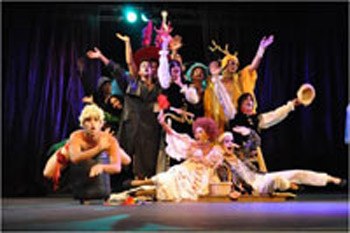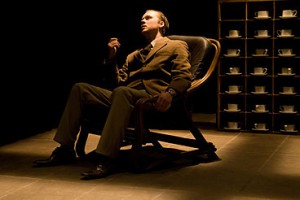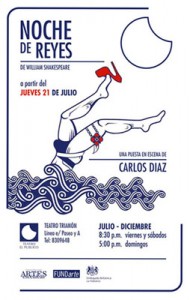Coffee Club & Burlesque at Havana Theater Fest
By Yael Prizant

HAVANA TIMES, Nov. 6 — Going to the theatre for 10 nights straight is an exhilarating and overwhelming prospect. It sharpens the eye and challenges the mind (not to mention the body), and, in the best of cases, allows greater access to one’s ideas.
The repetitive nature of festival attendance, of being a committed and respectful audience member night after night, has taught me about humility (the kind that comes from hoping I’ll actually get a seat) and a great admiration for artists (especially those working on shows with logistical problems to overcome).
The festival process allows for extensive comparisons of companies and production styles of course, but more importantly compels the most vivid theatrical impressions to rise to the fore. Two productions presented this week (of the five I attended), one by a Norwegian company and the other by a Cuban one, thoroughly resonated with me.
On November 1, I had the distinct pleasure of seeing Jo Strømgren Kompani’s abstract, stylized production of The Society. In this physical comedy, an association of dedicated coffee drinkers meets somewhere in Central Europe.
Their daily ritual, complete with sardonic, choreographed dances to honor the perfect cup of coffee, is interrupted when an appalling event occurs: the three men, dynamic actors Hallvard Holmen, Stian Isaksen, and Trond Fausa Aurvåg, discover a used tea bag.

The incident drives them to hilariously torture one another, with a space heater and an electrical cord, to determine who is responsible for the antagonistic tea bag in their midst. Yet before they can establish the culprit, a more horrific discovery is made: dozens of sets of chopsticks.
Amid their very funny yet pointed critique of an Asian infiltration are key questions about patriotism and conspiracies. I was surprised these topics were communicated so directly in Cuba, where agreements with the Chinese are crucial.
These Norwegians bravely ask how far we’re prepared to go to expose a traitor and bring him to justice. The simple, absurdist text, in a mixture of meaningless French, broken English, and nonsensical Chinese, relies heavily on the actors’ meticulous movements and expansive expressions to communicate the narrative.
This company’s success in over 45 countries proves that their mission, to stimulate specific interpretations linked to wherever they perform, is constructive and necessary. The production was ideal for a multilingual international audience and drew raucous laughter and applause.
Noche de Reyes, presented by Teatro El Público, is a raucous, hyper-sexualized, burlesque romp through William Shakespeare’s Twelfth Night. The piece occurs in the imaginary “new world” of Illira, where a kitschy clave to welcome “tourists” (actually those shipwrecked) on the island begins the production’s ongoing commentary on modern day Cuba.
The suggestive and witty costume design by Roberto Ramos anchors the visual exaggeration in this production. Duke Orsino, performed in only a gold sequined bikini and rockstar wig by Raphael Hernández, initiates the discussion of love in the play, but his crass sexual ambiguity immediately negates romantic ideals.

The play’s comic characters – Toby, Mariah and Andrew – are exaggerated to the hilt throughout; Toby’s bare behind appears on stage before we see his face. In this manner, director Carlos Díaz and playwright/adapter Norge Espinosa push the sexual references in the play to their absolute maximum, creating a carnival atmosphere where lewd corporeal liberation reigns.
There is astounding (constant and bold) male frontal nudity in the production, as well as dozens of crudely simulated sex acts, combined with every imaginable sexual joke alá Aristophanes.
However, there is much more to this production than its vulgar sexuality. It is a brash critique of modernity and class, an acknowledgement that much of Shakespeare’s original audiences were ruffians, prostitutes, and the poor.
Viola, one of the play’s protagonists, for example, enters searching for cellular phone service, sparking every character on stage with her to do the same.
Sebastián, her lost twin brother as played by Carlos Riverón, is a “guajiro” or Cuban hick with ridiculously affected language and mannerisms.
The cast also enact fervent critiques of Cuban identity, with uproarious references to the country’s identity cards, nationalistic songs and revolutionary slogans.
Overall the show is an enormous spectacle, with nearly twenty actors in a hilarious mixture of ever-changing sadomasochistic and period costumes with dramatic rock concert-style lighting, and a fashion show catwalk.
The language is simple and direct, rhyming for fun rather than for literary elevation, while the company’s social critiques are multivalent, much more specific than an international audience might appreciate.
Bold sight gags and every type of music from Cuban son to Lady Gaga create a pastiche of references that ends with the recognition of its own artifice: the characters crowd together on a central platform and wave as if on a carnival float. This final image reinforced the production’s insistence on play, fantasy, and daring entertainment.





